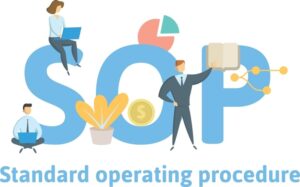Creating a comprehensive Business Process Manual, also known as Standard Operating Procedures (SOP), is essential for organizations striving for efficiency, consistency, and regulatory compliance. SOPs serve as a roadmap, providing detailed guidelines and instructions for carrying out various business processes consistently across the organization. Here’s how to craft a top-notch Business Process Manual:

1.Process Mapping:
Begin by mapping out all critical business processes within your organization. This involves identifying key activities, inputs, outputs, stakeholders, and decision points for each process. Process mapping helps gain a holistic understanding of operations and sets the foundation for developing SOPs.
2.Standardization:
SOPs aim to standardize processes to ensure consistency and quality. Define standardized procedures for each process, specifying step-by-step instructions, roles and responsibilities, required resources, timelines, and performance metrics. Standardization minimizes errors, enhances efficiency, and facilitates training and onboarding.
3.Clarity and Detail:
SOPs should be written with clarity and precision, using language that is easily understandable to the intended audience. Include sufficient detail to guide users through each step of the process, avoiding ambiguity or confusion. Visual aids such as flowcharts, diagrams, and screenshots can enhance clarity and comprehension.
4.Compliance and Regulations:
Ensure that SOPs align with relevant regulatory requirements, industry standards, and internal policies. Incorporate compliance checks, quality control measures, and documentation requirements into SOPs to mitigate risks and ensure adherence to legal and regulatory obligations.
5.User Involvement:
Involve end-users and subject matter experts in the development of SOPs to leverage their insights and expertise. Solicit feedback, conduct reviews, and incorporate suggestions to ensure SOPs accurately reflect the realities of day-to-day operations and are practical and user-friendly.
6.Accessibility and Version Control:
Make SOPs easily accessible to all relevant stakeholders through a centralized repository or document management system. Implement version control mechanisms to track revisions, updates, and approvals, ensuring that users always have access to the latest version of SOPs.
7.Training and Communication:
Develop training programs to educate employees on SOPs, emphasizing the importance of adherence to established procedures. Communicate changes or updates to SOPs effectively, providing adequate training and support to facilitate smooth transitions and compliance.
8.Continuous Improvement:
SOPs should be living documents that evolve with changing business needs, technology advancements, and lessons learned. Establish a process for regular review, evaluation, and updating of SOPs to incorporate feedback, address gaps, and optimize processes for ongoing improvement.
By following these best practices, organizations can develop robust Business Process Manuals (SOPs) that serve as invaluable resources for standardizing operations, ensuring compliance, and driving operational excellence across the organization.